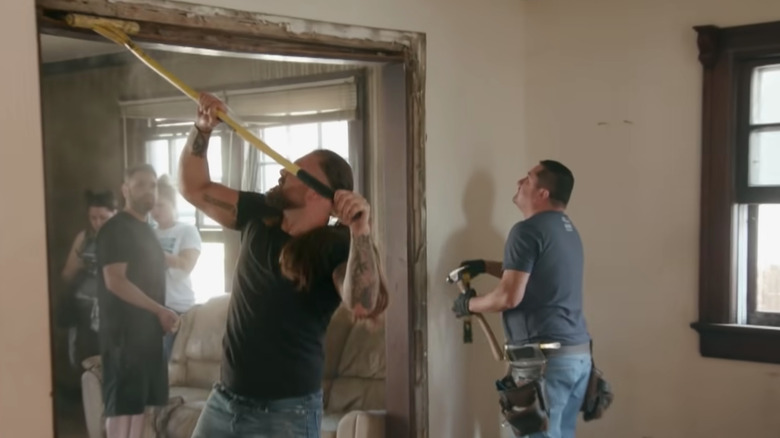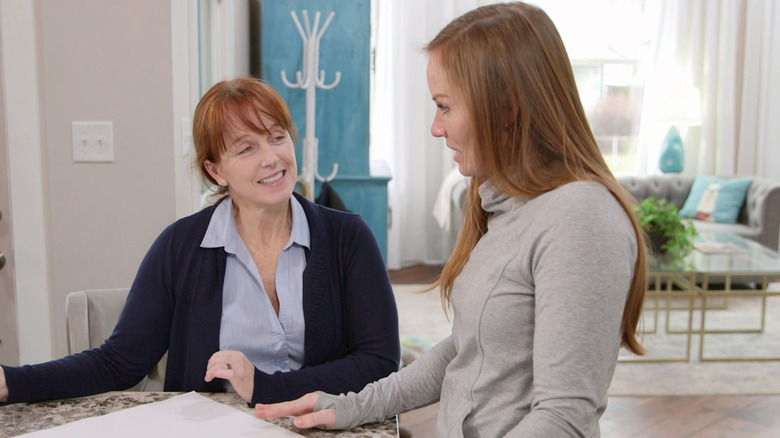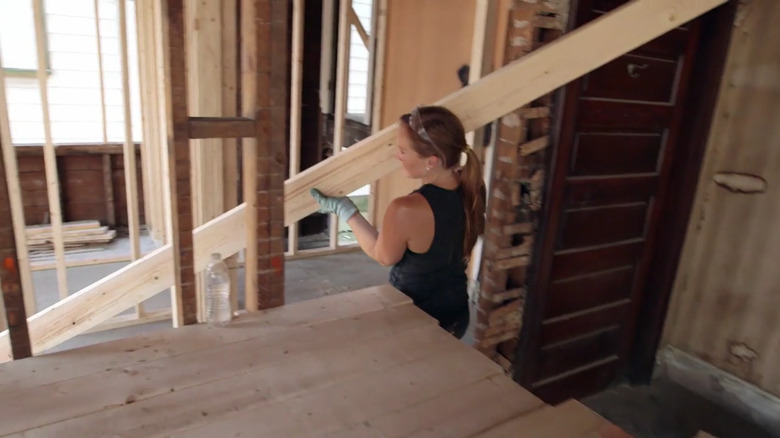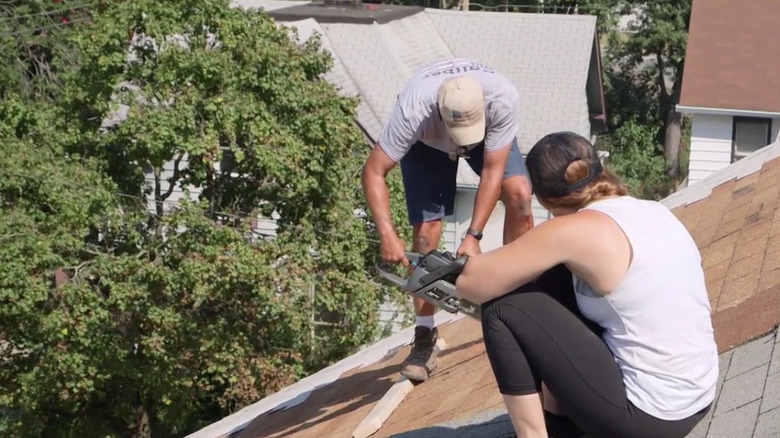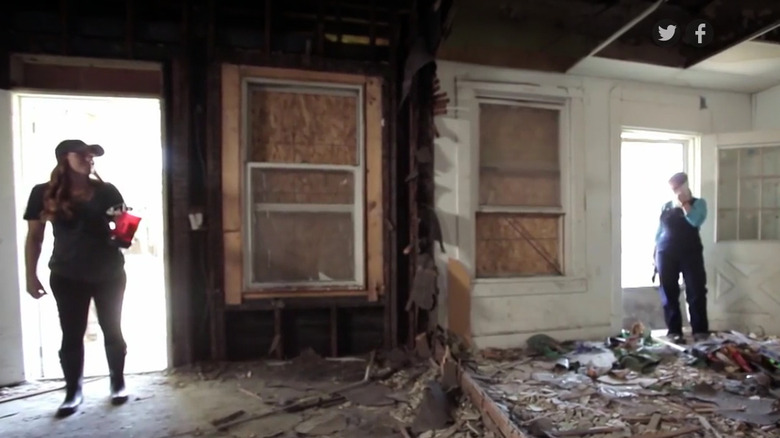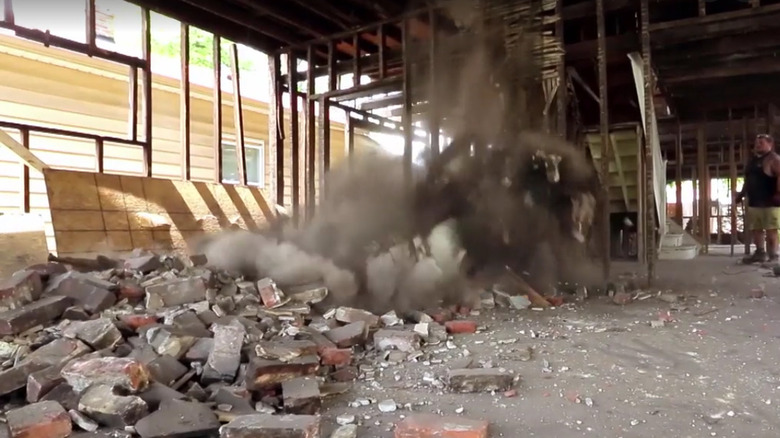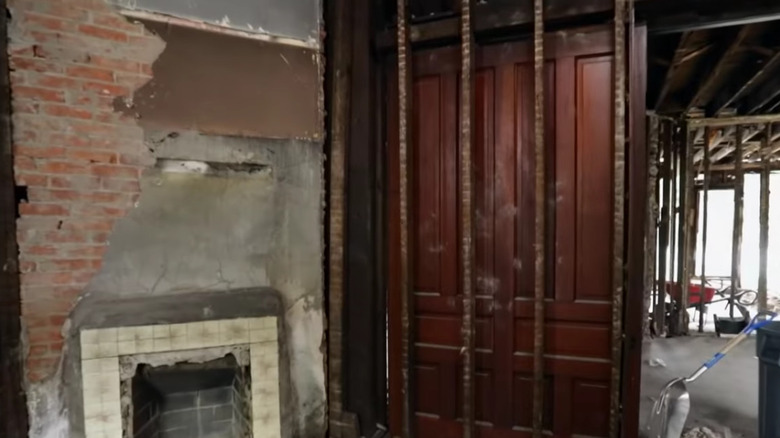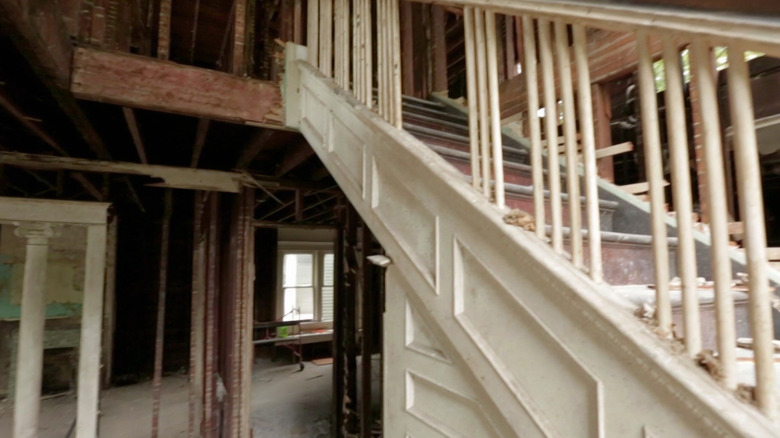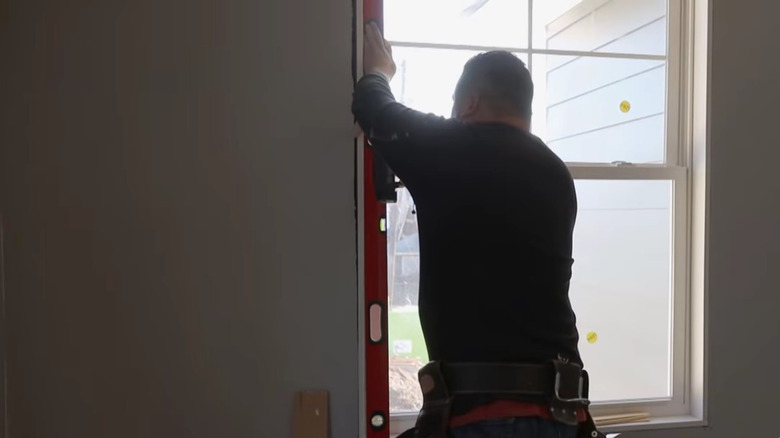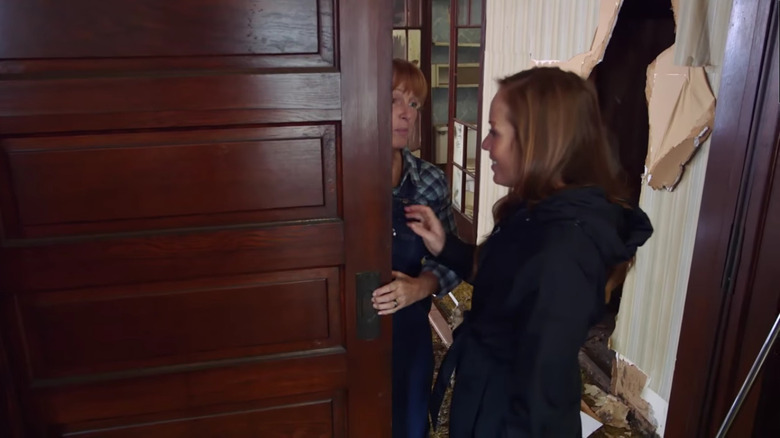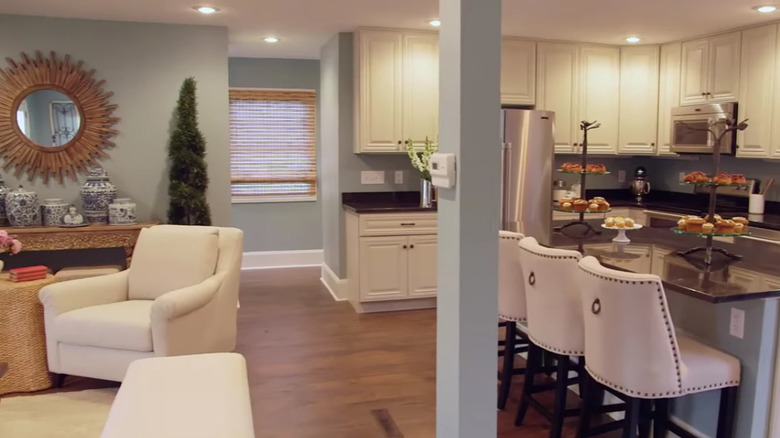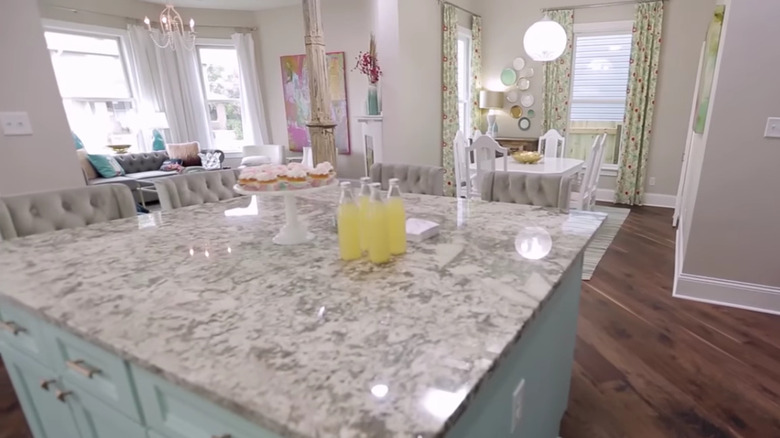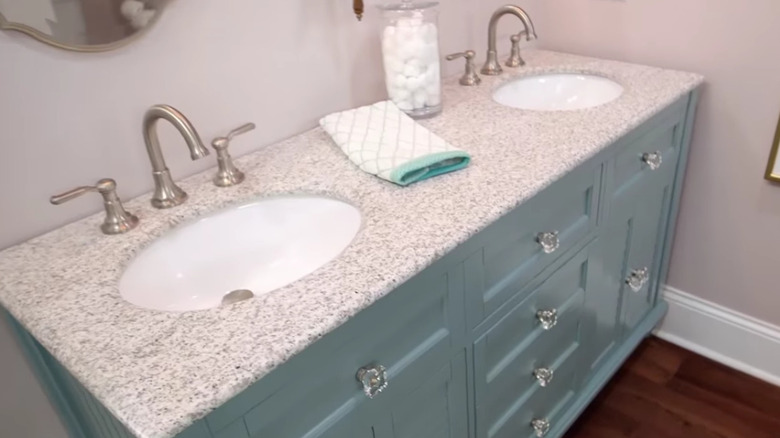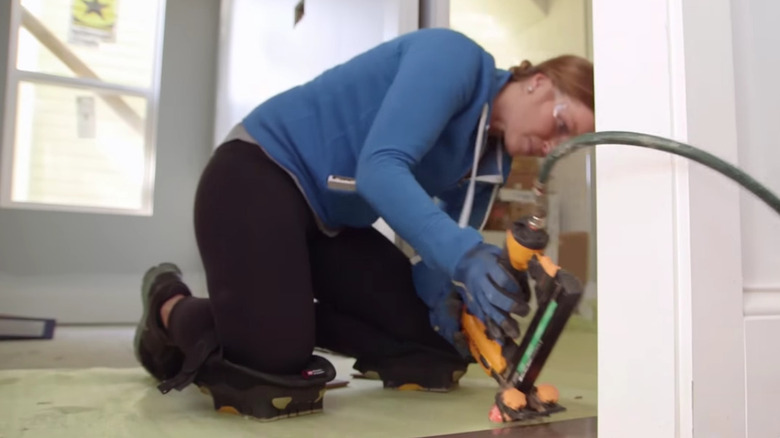Bad Advice Dished Out On Good Bones
Taking a "we can fix anything" approach to homebuying carries the dangers of hidden costs and much longer timelines than you might think. When it comes to home buying and renovation, not all advice is created equal. The hosts of "Good Bones" might give you the impression that a total renovation, including all new appliances, fixtures, and top to bottom refinishing is the best way to increase the value of a home, but this isn't always true. According to Remodeling Magazine, the return on kitchen and bathroom renovations continues to fall, and may begin depreciating within a few years of the project. Being careful to do your research before selling or buying will save you money and frustration in the end.
If you're a fan of the show, you know that mother/daughter duo Karen E. Laine and Mina Starsiak Hawk often buy houses sight unseen. This practice might be fine if you're a real estate professional, but a home inspection is a must for ordinary folks. Danielle Tucker, a real estate agent with Coldwell Banker United in Austin, told HuffPost, "With all of the buyers I represent, I strongly push for a home inspection to be performed by a third-party inspector that they hire ― someone who works for the buyer and not the builder." Many pitfalls can occur in the process of home renovation. Here are some examples of what not to do when buying or renovating a home, even if "Good Bones" endorses it.
You can skip the safety gear
Throughout the show, you'll see the hosts and their helpers swinging hammers, wielding power tools, and flinging refuse, all without a hard hat, safety glasses, or a mask. There's a reason construction workers wear these things; they protect your head, eyes, and lungs. These precautions can seem unnecessary when performing a DIY renovation until something unexpected happens, leading to a preventable injury.
According to Johns Hopkins Medicine, about 2.5 million people will have a serious eye injury every year. The best way to prevent eye injuries is to wear proper goggles or glasses, so wearing the correct personal protective equipment is very important. Demolition day can be lots of fun, but not at the expense of your safety. Nothing will spoil your home renovation project faster than a trip to the ER, so follow some good advice from The Family Handyman and stock up on safety equipment before tackling any DIY home improvements.
You can and should be your own general contractor
Watching the show, you might get the impression that you can and should be your own general contractor. However, hiring a good general contractor can save you money because they will have established relationships with subcontractors and can get a better rate, according to Forbes. A good general contractor will know building codes and what pitfalls to look out for. In addition to getting your project on budget, hiring a contractor can take the stress of project management off your plate and make sure your work gets done on schedule. According to The Washington Post, it's easy to overspend on materials while underestimating the increased cost of making mistakes, making small changes, and underestimating the time required.
While you might only see a fraction of what goes into running an extensive renovation project on the show, sourcing materials, applying for permits, planning for utilities to be on and off at the correct times, and about a thousand other things have to happen behind the scenes to complete a renovation. According to BuildingAdvisor, you won't save as much money as you think being your own contractor, and it could even cost you if you run into any unforeseen issues with construction. While it is possible to be your own contractor, the headaches, time constraints, and paperwork might not be worth it. It's important to consider all the pros and cons before jumping into the deep end.
You should renovate before you move in
Getting a feel for your home before deciding how you want to change it can lead to better decisions. Also, taking your time and making better long-term decisions will make your house more liveable in the future, according to Vision Realty, and you might change your mind once you've been there a while. For instance, realtor Brendon DiSimone points out in his piece for Insider that once you've spent some time living in a house, there might be things you didn't notice that you'd like to change. It's much more expensive to redo something that's already been done than it is to plan ahead, giving yourself the full picture of your project.
Tackling things that are safety hazards before you move in is fine. Still, the most budget-friendly option for renovating your home will be to move in first and take a full year before making any significant improvements, says Frugalwoods. Saving money by using reclaimed materials and even garage sale finds is possible only by planning ahead and resisting the urge to see results immediately. We all love shiny new things, but impulse control is a must when making big financial decisions.
You can DIY everything
Reality TV can lead people to believe anyone can become a remodeling expert in a short amount of time, but not everything is simple to do yourself. You might end up wasting time and money as well as creating hazards and future headaches. Jane Lockhart, an interior design specialist, advises people to do their research before attempting a DIY project. She says that reality TV sometimes promotes the illusion that anyone can do anything, but the reality is quite different. She recommends checking with a contractor before attempting home repairs yourself if they involve plumbing or wiring, and not relying on videos as your only source of information.
Angi noted that 80% of homeowners surveyed reported some kind of mistake when performing a DIY repair. That means that most people who attempt a DIY project will have some sort of problem as a result. Bailey Carson, head of the Book Now service at Angi, advises weighing why you want to DIY. "If you're doing it just to save money, you might want to reconsider. Without the time, tools, and talent to do it properly and safely, mistakes may cost you more in the long run than simply having a pro come in to help from the beginning," she said in a press release.
Everything is worth fixing
Some problems aren't realistically solved by the average home buyer. While "Good Bones" makes it look simple to solve almost any problem within a home, that's not realistic for most people. Termites, bad wiring, and crumbling foundations all pose issues that might be more work than they're worth fixing. Building codes, budgets, and timelines should be considered before taking on a major rebuild. Certain types of major repairs should be a deal-breaker, according to The American Society of Home Inspectors. Even if they're addressed, problems that can persist, like mold, infestations, or frequent flooding, all belong to a list of deal-breakers.
What you might not realize when watching "Good Bones" is that Mina and Karen are buying houses as-is, meaning that they are taking on all of the responsibility for repairs. Unless you have a team of contractors and experts on staff to get you through demolishing and rebuilding an entire structure, you shouldn't buy a house with significant problems. Most regular home buyers not in the real estate business will have a home inspection before purchasing a house, and this will include certain mandatory repairs before a sale can go through. According to Realtor, mandatory repairs include most major home systems, and are the seller's responsibility.
You should tear down walls
Just because a wall isn't load bearing doesn't mean there's no other reason not to knock it down. Some walls carry electrical, plumbing, or HVAC. You need to look for more than just floor joists before smashing them with a hammer. Angi recommends consulting a professional to determine whether or not a wall is a load-bearing, as well as taking steps to ensure that you don't damage any of your home's systems during the demo. Speaking with The Washington Post, architect Sean Mullin advises that every wall should be assumed to be load-bearing until it is proven to be otherwise. A mistake when performing a DIY wall demolition can be costly — not to mention dangerous.
Also, an "open concept" layout isn't for everyone. Noise, lack of defined space, and maybe a little too much togetherness are some reasons that not everyone loves the open floor plan trend, says The Money Pit. Keeping dirty dishes out of your sight when you're trying to concentrate on something else is also a strong motivator.
You should repurpose old doors and molding
What you don't see much of on "Good Bones" when Karen finds an old door or column she wants to keep is the process of safely testing these items for lead and stripping the paint off. Older homes often have lead paint, so you need to test for it and take proper precautions before reusing materials that might contain it. This Old House warns that structures built before 1978 can have potentially harmful lead levels and can pose a danger when in the form of dust or chips. So dry-sanding or any activity that causes particles of paint to enter the environment is especially hazardous.
While it can be possible to salvage items with lead paint, it's an exhaustive process, as described by Yellow Brick Home. Safety gear includes disposable coveralls, a respirator with the proper cartridges, and goggles. Clean-up for this project is also important since lead dust can enter your bloodstream through your lungs. To avoid lead poisoning, these safety measures are very important.
It's simple to move a staircase
Watching "Good Bones," you might think that changing the ground plan of a home is simple, but some things like moving a staircase can be a challenge. The process of moving the position of stairs in a house is more complex than it might seem, and almost always requires permits because of the structural elements it involves. This is something that needs to be done safely and with proper planning. Weekend Builds points out that not only might the staircase be difficult to move, but the walls around the stairs might also be load-bearing, making this an even more complex job.
Not only is moving a staircase complicated, but according to HomeAdvisor, the average cost to move a staircase is $1,950. You can also expect to spend more for custom builds, to add railings, or replace the treads. So it is often possible to relocate stairs, but it isn't as simple as what you might think watching Mina and Karen's magic plans come to life. If you don't have experience, it's not something to try doing on your own.
You should replace your old windows with vinyl
Old windows can and should be restored rather than replaced. Original windows on an old house increase its value and can be made energy efficient with storm windows and other modifications. Forbes points out that the life of new vinyl replacement windows is much shorter than restored original windows, so the restoration is actually more cost-effective in the end. Matthew Cummings, an architect based in Ipswich, Massachusetts, who has worked on some of America's most historic homes, told Forbes, "Never, never, never throw away old windows." He continues: "People replace 200-year-old windows with new vinyl ones that are guaranteed for five years. They are made of oil products and evil gasses and soon their useful life is over and they end up in the landfill. Old windows are made of clean wood and glass, and, once rebuilt, are good for another 200 years."
Also, they look better. According to The Craftsman Blog, restored original windows not only last longer, but can increase the resale value of your home. In a market where curb appeal is most of the game, authenticity goes a long way, especially with historic properties.
You should take out pocket doors
In the pursuit of an open floor plan, Mina and Karen have torn down lots of old pocket doors on "Good Bones," but pocket doors can be a great part of a versatile space. They save wall space by sliding behind the wall instead of opening into the room, making them functional as well as beautiful. According to Bob Vila, pocket doors are making a comeback as part of a new concentration on versatile rather than static floor plans.
In addition to being versatile, pocket doors also provide clean lines and more wall space. According to Home Reference, pocket doors can provide flow to a room that a swinging door would ordinarily shut off. You can choose to leave the doors open when you want a larger space, and you can use them to close off sections of your home for more privacy. Ripping out a pocket door can hurt a home's charm and historic authenticity.
You need to replace everything in your kitchen for good results
Watching "Good Bones" can give you the impression that complete renovation is the only way to have a beautiful and functional kitchen, but not everyone has the budget to do a complete remodel. Updating your kitchen can be simple and budget-friendly. Save your money for the big things you might need, like new appliances, and do simpler updates on the rest. Real Simple suggests some fresh paint or swapping out hardware to get results without replacing everything.
If you're planning to sell your home, researching what to spend your money on in terms of improvement is key. According to NerdWallet, minor renovations like resurfacing cabinets have a much higher return on investment than major renovations like reconfiguring the floor plan or adding an island. You should consult a local real estate expert to find out what updates will get you the best return to avoid making expensive mistakes.
Granite is the best countertop material
Watching Mina pick out countertops on "Good Bones," you might believe that granite is the best if not the only option for kitchens. But granite is just one of many legitimate countertop choices. There are other stone and non-stone materials to pick from, including butcher block and concrete. According to The Family Handyman, there are many alternatives to granite counters that are functional, stylish, and affordable. Materials like resin, laminate, and recycled glass are just a few attractive alternatives when selecting your counters.
According to Forbes, granite countertops are pretty, but they're also pricey. Granite can cost as much as $180/square foot and is almost impossible to repair if it gets damaged. While granite is durable, it also requires maintenance to prevent staining. It needs to be sealed every year to keep its surface spotless. While granite is a good option for some people and can be a great part of your kitchen, it does have its drawbacks, so it isn't for everyone.
You need to replace everything in a bathroom to improve it
On "Good Bones," all the bathroom fixtures end up in the dumpster, and in some cases, that's the right call. In real life, though, while some things might need replacing, others could just get repaired. Save money by re-grouting your tile instead of replacing it, or resurfacing your tub rather than ripping it out and adding a new one, says The Spruce. You can get a new look without spending a lot, depending on what condition your bathroom fixtures are in to start with. Resurfacing rather than replacing an old clawfoot tub will give you beautiful and satisfying results, as well as keep the old tub in use and out of the landfill.
To update your bathroom quickly, try painting your vanity cabinets and trim to match or tiling just one accent wall, says Better Homes and Gardens. You can also replace your toilet seat or swap out your old showerhead for a new one for more practical results. The experts at Better Homes and Gardens also advise DIYers not to be afraid of color. Adding a bright accent is a cost-effective and quick way to punch up an old bathroom.
You need to replace hard wood with laminate flooring
Nearly every house on "Good Bones" gets some kind of laminate installed, even in historic and vintage homes. While laminate flooring is cheaper in the short term and can be simpler to maintain, hardwood floors last longer and are more environmentally friendly. According to HomeAdvisor, hardwood floors can last for generations, and in some cases, even increase the resale value of your home. While laminate has its place in bathrooms and moist areas of the house, hardwood wins out for safety, long-term durability, and ease of repair.
If you're looking for a return on investment, new wood flooring has a rate of 106%, says HomeLight. When choosing a flooring material, consider that homes with hardwood floors brought in up to 10% more than similar houses without, and people who live in homes where they have added new wood floors report liking their homes more after the change. Adding to the overall value of your investment and the livability of your home is a win-win.

